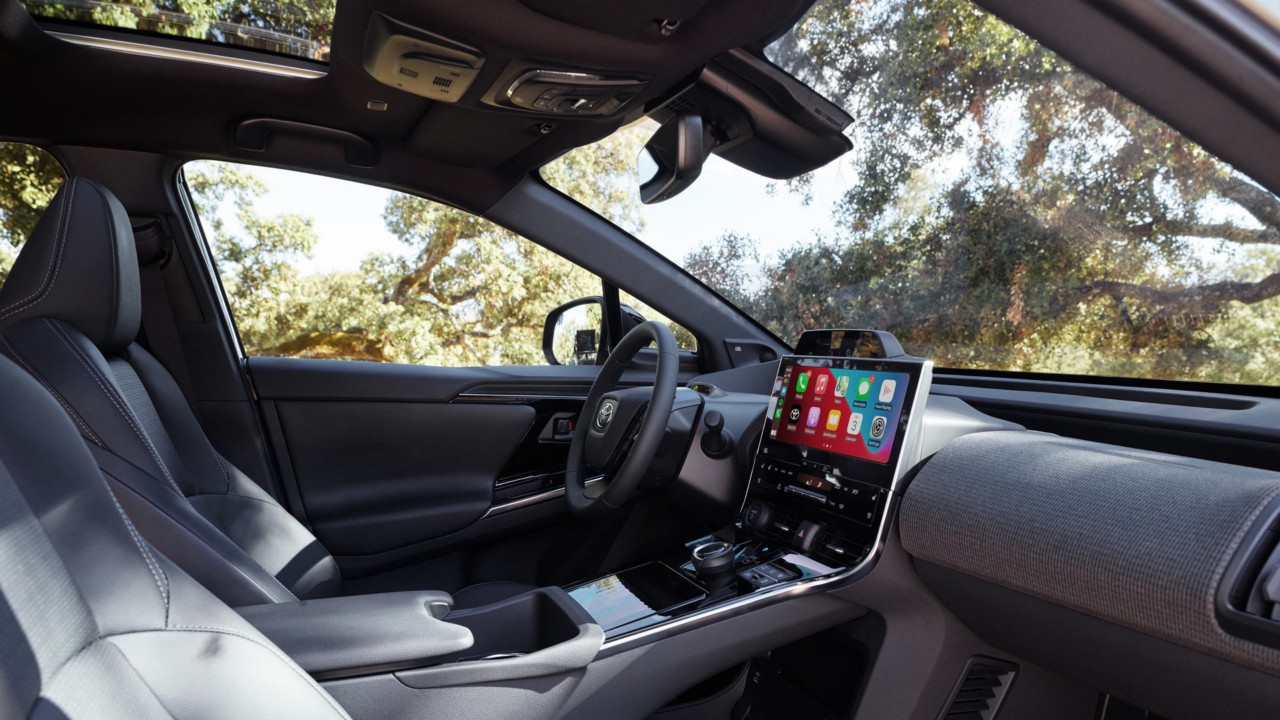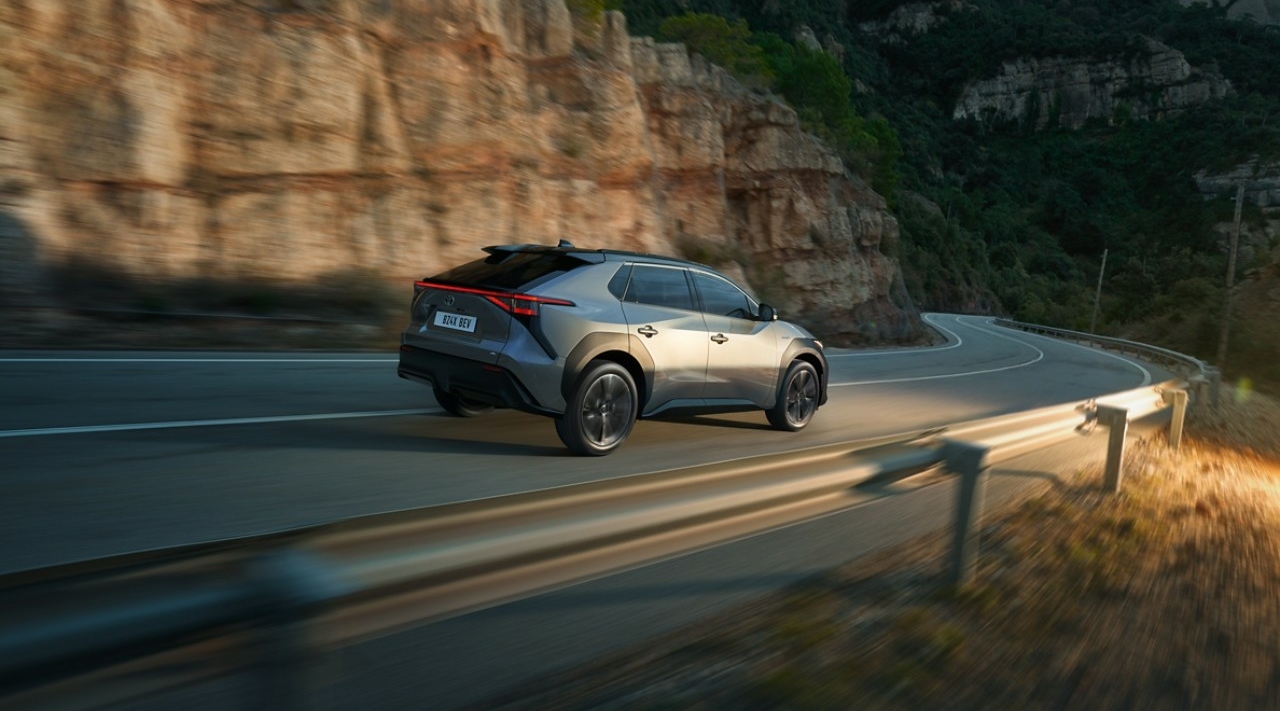Can the bZ4X repeat Toyota’s global success with the Prius in a fully electric era?
Toyota is the world’s best-selling manufacturer, selling 11 million cars last year. After creating a global icon with the best-selling Prius hybrid, can the bZ4X electric SUV achieve similar success? James Hamill puts it to the test.
Fact file
Brand: Toyota
Model: bZ4X Vision
Fuel: Electric
0-62mph (secs): 7.5
Range (WLTP miles): 280
Battery (kWh): 71.4kWh
Want to drive this car? Contact the Reflex team!
Toyota is the brand that brought hybrids to the masses with the best-selling Prius, which has achieved more than 20 million sales globally, so its first electric vehicle has a lot to live up to.
The bZ4X’s name has less of ring to it than Prius, especially when someone asks what you are driving, but there is method to this new naming convention.
BZ represents ‘beyond zero’ (as in zero-emissions), while 4 is an indicator of size (like the RAV4), and X denotes crossover.
It faces a growing list of very capable competitors, from the Ford Mustang Mach-E to the Tesla Model Y that is currently dominating global sales charts.
So, what does the bZ4X have to offer beyond a name that looks like a Wi-Fi password? We took it out on the road to find out.
Exterior
The bZ4X has quite a striking design, with lots of angles that help it stand out compared to a typical mid-sized SUV. I have always been a fan of ‘funky’ design, so I really like the shape. As it’s a Toyota, everything is well built and there are nice design touches, such as concealed front parking sensors that give a cleaner look.
You need to choose the right body colour to complement the black panel sections over the wheels. Fans of a ‘frunk’ for extra storage under the bonnet will be disappointed, as the bonnet just hides a mass of electrical engineering.
Interior
The interior is as you would expect it to be from Toyota. It’s not fancy, but everything is well built and does its job well. There are nice touches, such as the upholstered finish on the dashboard, although the shiny black plastics on the consoles will show up fingerprints. The centre console is dominated by an infotainment screen, while the driver has an instrument pod set back towards the windscreen. You tend to look over the top of the steering wheel, rather than through it, similar to Peugeot’s i-Cockpit.

Practicality
There is a little extra legroom for front seat passengers because there is no glovebox. Instead, the large centre console caters for your needs, with a useful tray offering wireless charging for your phone.
The centre console is well thought out, with physical buttons for controlling commonly used functions, such as temperature. A lot of cars have opted for touch sensitive controls, which can be hit or miss. A button gives you the touch feedback you need when adjusting your radio volume or heating.
In the rear, the sloping roofline can encroach on taller passengers, but otherwise there is enough space, helped by the flat floor. Rear seat occupants also have their own USB-C ports.
The rear seats fold down to create a sizeable load area, with hooks to keep cargo from sliding around. The sloping roof line means it’s not as expansive as some rivals, though. Under the floor, there is additional storage and a home for charging cables.
You can order the bZ4X with a towbar and it can pull up to 750kg.
Driving
As a driver of an EV car, you expect suspension to ‘bouncy’, but the bZ4X is more composed and takes the edge off sharper bumps. Overall, it’s a smooth ride and it performed well on country lanes, holding its line in corners and smoothing out imperfections. On the motorway it was easy to drive, and while it doesn’t offer the head-jolting instant acceleration of some other EVs I have driven, the progressive power deliver makes the most of its smooth drivetrain.
There is more good news when it comes to efficiency. During my test, the bZ4X averaged 3.5 miles per kWh, close to its official average, giving it a potential range of around 250 miles.
Toyota also offers peace of mind on the 71.4kWh battery, which comes with a warranty of up to 10 years.
The bZ4X’s battery comes with a choice of two electric motor options. A front-wheel drive version, including the Vision specification model we tested, uses a single electric motor, delivering 204hp, which equates to 0-62mph performance of 7.5 seconds. An all-wheel drive version introduces an electric motor on each axle, with selectable off-road driving mode, delivering 218hp and a 6.9 second 0-62mph time. More power equates to less range, with the official figure dropping from 280 miles to 260 miles. The 20-inch wheels fitted on the Vison could also reduce range compared to the standard 18-inch option, although our test model was very efficient.

Technology
The car feels packed with technology and it is easy to access with the large touchscreen infotainment system, which is cloud-enabled so the car can receive over-the-air updates. There are plenty of safety features, cameras and a driver alert system that gives you a friendly reminder to keep your eyes on the road if it senses you are distracted.
The car is also fitted with an energy-saving heat pump, which reduces battery drain when heating or cooling the car.
Summary
I have been a fan of Toyotas for many years, so I know what to expect from one. Even though this is their first EV, it doesn’t disappoint. Despite the more modern design, this is a Toyota at heart, with a sensible approach to the interior that is well thought-out. There is nothing flashy, but everything is where you would want it to be. The drive is simple yet smooth and above all, you always know that you'll get the reliability you expect from a Toyota.
It puts usability before any gimmicks and the car is all the better for it, as it just does everything well.
Reflex rating
9/10
Share to:
ROAD TESTER PROFILE
Name: James Hamill
Role: Parts Manager
Likes: Taking a scenic route
Dislikes: Drivers seemingly always in a rush
Dream car: Shelby AC Cobra
Find out more
Find out how Reflex Vehicle Hire can help your company.
Call 0330 460 9913 or visit our contact us page.







@2x.png)

